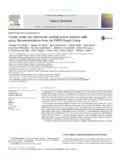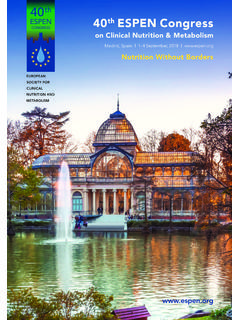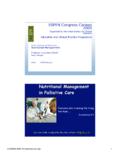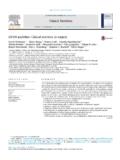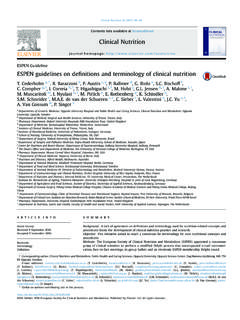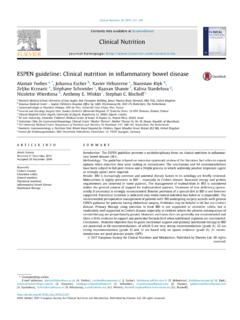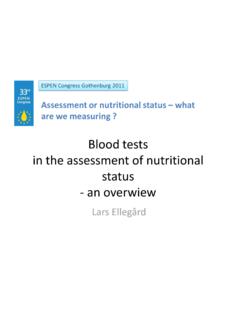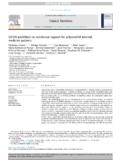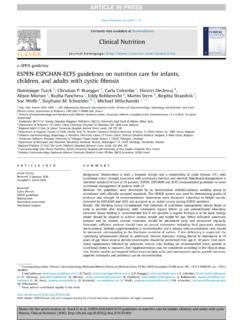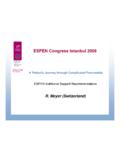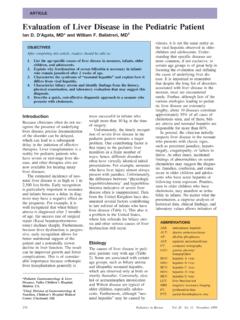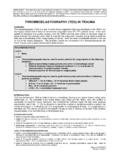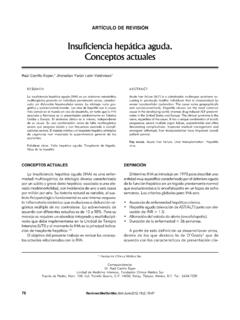Transcription of ESPEN practical guideline: Clinical nutrition in liver disease
1 ESPEN GuidelineESPEN practical guideline: Clinical nutrition in liver diseaseStephan C. Bischoffa,*, William Bernalb, Srinivasan Dasarathyc, Manuela Merlid,Lindsay D. Planke, Tatjana Sch tzf, Mathias PlauthgaDepartment for Clinical nutrition , University of Hohenheim, Stuttgart, GermanybInstitute of liver Studies, King's College Hospital, London, United KingdomcDivision of Gastroenterology and Hepatology, Cleveland Clinic, Cleveland, OH, USAdGastroenterology and Hepatology Unit, Sapienza University of Rome, Rome, ItalyeDepartment of Surgery, University of Auckland, Auckland, New ZealandfIFB Adiposity Diseases, Leipzig University Medical Centre, Leipzig, GermanygDepartment of Internal Medicine, Municipal Hospital of Dessau, Dessau, Germanyarticle infoArticle history:Received 31 August 2020 Accepted 9 September 2020 Keywords:MalnutritionSarcopeniaAcute liver failureFatty liver diseaseCirrhosisTransplantationsummaryBa ckground:The practical guideline is based on the current scientific ESPEN guideline on ClinicalNutrition in liver :It has been shortened and transformed intoflow charts for easier use in Clinical practice.
2 Theguideline is dedicated to all professionals including physicians, dieticians, nutritionists and nursesworking with patients with chronic liver :A total of 103 statements and recommendations are presented with short commentaries for thenutritional and metabolic management of patients with (i) acute liver failure, (ii) alcoholic steatohepa-titis, (iii) non-alcoholic fatty liver disease , (iv) liver cirrhosis, and (v) liver surgery/ transplantation . Thedisease-related recommendations are preceded by general recommendations on the diagnostics ofnutritional status in liver patients and on liver complications associated with medical :This practical guideline gives guidance to health care providers involved in the managementof liver disease to offer optimal nutritional care. 2020 European Society for Clinical nutrition and Metabolism. Published by Elsevier Ltd. All IntroductionIt is well-known that nutrition has a central prognostic andtherapeutic role in the management of patients with liver , ESPEN produced scientific guidelines on this topic since1997.
3 To improve implementation and dissemination of theseguidelines into Clinical practice, a shortened version has beencreated based on the most recent ESPEN guideline on clinicalnutrition in liver disease [1]. Apart from shortening the commen-taries, we have grouped the recommendations differently accord-ing to thefive major liver diseases with a strong relation tonutrition including acute liver failure (ALF), alcoholic and non-alcoholic steatohepatitis (ASH and NASH), liver cirrhosis, livertransplantation (LTx) and other surgery. Moreover, we supple-mented the text withflow charts to support guidance in nutritionaltherapy and to allow online versions of the guideline such as an appand a web version (Fig. 1). This guideline is aimed to address clin-ically relevant issues in the nutritional and metabolic managementof adult patients with liver disease . Target users of the guideline arehealth care providers involved in the care of patients with liverdisease, medical specialists involved in the management of liverdisease, family physicians, pharmacists, nurses, dieticians, nutri-tionists, as well as by medical leaders and administrators of MethodologyThe present practical guideline consists of 85 recommendationsand 17 statements, all based on the current ESPEN Guideline onclinical nutrition in liver disease [1].
4 The original guideline wasshortened by restricting the commentaries to the gatheredBased on. Plauth M, Bernal W, Dasarathy S, Merli M, Plank LD, Sch tz T, BischoffSC. ESPEN guideline on Clinical nutrition in liver disease . Clin Nutr. 2019; 38:485e521.*Corresponding Bischoff).Contents lists available atScienceDirectClinical Nutritionjournal homepage: 2020 European Society for Clinical nutrition and Metabolism. Published by Elsevier Ltd. All rights nutrition 39 (2020) 3533e3562evidence and literature on which the recommendations are basedon. The recommendations were not changed, but the recommen-dations and statements were re-ordered and grouped to diseaseentities. Most relevant, presentation of the content was trans-formed into a graphical presentation consisting of decision-makingflow charts wherever possible. The original guideline was devel-oped according to the standard operating procedure (SOP) forESPEN guidelines [2]. This SOP is oriented on the methodology ofthe Scottish Intercollegiate Guidelines Network (SIGN).
5 Literaturewas searched and graded into 1e4 according to evidence, andrecommendations were created and graded into four classes (A/B/0/GPP). All recommendations were not only based on evidence, butalso underwent a consensus process, which resulted in a percent-age of agreement (%). Whenever possible, representatives fromdifferent professions (physicians, dieticians, nurses, others) as wellas patient representatives were involved. The guideline processwas funded exclusively by the ESPEN society. The guidelineshortage and dissemination was funded in part by the UEG society,and also by the ESPEN society. For further details on methodology,see the full version of the ESPEN guideline [1] and the ESPEN SOP[2]. General Diagnostics of nutritional status (Fig. 2) Impact of nutrition1)Malnutrition can impair the whole spectrum of hepaticmetabolic functions. Malnutrition alone can cause severefatty liver but is not known to cause chronic liver disease .(Statement 14, strong consensus 100%)Severe malnutrition in children can cause fatty liver which ingeneral is fully reversible upon refeeding.
6 In children withAbbreviationsALFacute liver failureASHalcoholic steatohepatitisBCAA branched chain amino acidsCTcomputed tomographyDXAdual energy X-ray absorptiometryENenteral nutritionICUintensive care unitIFALD intestinal failure associated liver diseaseLTxliver transplantationMCTmedium-chain triglycerideMedDMediterranean dietMRTmagnetic resonance tomographyNAFLnon-alcoholic fatty liverNAFLD non-alcoholic fatty liver diseaseNASHnon-alcoholic steatohepatitisONSoral nutritional supplementsPEGpercutaneous endoscopic gastrostomyPNparenteral nutritionPNAC parenteral nutrition -associated cholestasisPNALD parenteral nutrition associated liver diseaseREEresting energy expenditureFig. of the ESPEN practical guideline: Clinical nutrition in liver disease . Bischoff, W. Bernal, S. Dasarathy et nutrition 39 (2020) 3533e35623534 Fig. of nutritional status in liver disease (ALF, acute liver failure; ASH, alcoholic steatohepatitis; CT, computed tomography; DXA, dual energy X-ray absorptiometry;LTx, liver transplantation ; MRT, magnetic resonance tomography; NAFLD, non-alcoholic fatty liver disease ; NASH, non-alcoholic fatty liver disease ; REE, resting energy expenditure).
7 Fig. associated with medical nutrition in liver disease (EN, enteral nutrition ; PN, parenteral nutrition ; PNAC, parenteral nutrition associated cholestasis; PNALD,parenteral nutrition associated liver disease ). Bischoff, W. Bernal, S. Dasarathy et nutrition 39 (2020) 3533e35623535 Fig. nutrition in acute liver failure part 1 (ALF, acute liver failure; EN, enteral nutrition ; ONS, oral nutritional supplements; PN, parenteral nutrition ).Fig. nutrition in acute liver failure part 2 (ALF, acute liver failure; EN, enteral nutrition ; ONS, oral nutritional supplements; PN, parenteral nutrition ). Bischoff, W. Bernal, S. Dasarathy et nutrition 39 (2020) 3533e35623536 Kwashiorkor, there seems to be a maladaptation associated withless efficient breakdown of fat and oxidation of fatty acidscompared to children with marasmus. An impairment of fatty acidremoval from the liver could not be ) liver disease patients should be screened for malnutritionusing a validated tool. (Recommendation 3, grade B, strongconsensus 93%)NRS-2002 and MUST are validated tools to screen hospitalizedpatients for risk of malnutrition [3,4] and are recommended byESPEN.
8 The Royal Free Hospital nutrition Prioritizing Tool hasbeen developed as a screening tool for malnutrition in liver dis-ease patients. In a head-to-head comparison, the Royal FreeHospital nutrition Prioritizing Tool was more sensitive than theNRS-2002 to identify liver patients at risk for malnutrition [5].NRS-2002 was considered helpful in identifying malnourishedcirrhosis patients with hepatocellular carcinoma [6]. According toa recent review, none of the available screening tools has beenvalidated rigorously in cirrhosis patients leaving the Royal FreeHospital nutrition Prioritizing Tool as the best option currentlyavailable [7]. Body composition and sarcopenia3)Phase angle (measured by bioelectrical impedance analysis)or handgrip strength allow assessment of mortality risk.(Statement 10, strong consensus 93%)Handgrip strength is a good predictor of the rate of complica-tions within the next year [8]. Handgrip strength appears a valuabletool to measure efficacy of nutritional intervention [9].
9 Reactanceand resistance readouts from BIA can be used to calculate phaseangle or body cell mass as a measure of cell mass and cell functionfor the nutritional assessment. In liver cirrhosis, low phase angle isassociated with increased mortality as in many other disease en-tities [10].4)In NASH, cirrhosis and LTx, the presence or absence of sar-copenia should be assessed since sarcopenia is a strong pre-dictor of mortality and morbidity. (Recommendation 4,grade B, strong consensus 100%)In cirrhosis patients on the transplant wait list, impaired musclefunction in terms of 6-min walk distance, grip strength and theshort physical performance battery but not loss of muscle mass interms of computed tomography (CT) derived skeletal muscle indexwas associated with increased mortality [11]. In cirrhosis patients,frailty experienced as a functional decline in grip strength, gaitspeed, chair stands or short physical performance battery has beenshown associated with increased risk for complications requiringhospitalization [12] or death on the wait list or delisting [13,14].
10 5)Radiologic methods (dual energy X-ray absorptiometry(DXA) or when CT/magnetic resonance tomography (MRT)images are available for other reasons) should be used todiagnose sarcopenia. (Recommendation 5, grade B, strongconsensus 100%)Sarcopenia is the key feature of malnutrition in cirrhosis pa-tients and can be assessed by radiologic methods (DXA, CT) todetect loss of muscle mass or by tests of muscle function such asexercise test or 6-min walk distance. Sarcopenia can be diagnosedwhen there is loss of muscle mass or muscle function. On CT imagesat the level of lumbar vertebra 3 [15] or lumbar vertebra 4 [16]skeletal muscle area can be measured and normalized for nutrition in alcoholic steatohepatitis part 1 (ASH, alcoholic steatohepatitis; ONS, oral nutritional supplements). Bischoff, W. Bernal, S. Dasarathy et nutrition 39 (2020) 3533e35623537 The skeletal muscle area at L3 has been shown to be linearlycorrelated with whole body muscle mass [17]. Loss of skeletalmuscle mass on CT has been associated with increased mortality incirrhosis patients [15,16,18], obese cirrhosis patients [19], cirrhosispatients wait listed for transplantation [20] and in orthotopic livertransplant recipients [21e23].
